Management Accounting Report: Analyzing Corporate Holiday Packages
VerifiedAdded on 2023/06/14
|15
|2507
|335
Report
AI Summary
This management accounting report analyzes the profitability of corporate holiday packages offered by Asian Adventure Holidays. It evaluates the Bali Adventure, Thailand Discovery, and Malaysian Orienteering packages, examining sales revenue, direct costs, and overhead expenses. The report critiques the current method of profitability calculation and suggests improvements, focusing on individual package characteristics. It also addresses economic order quantity (EOQ) calculations, supply chain management (SCM), customer relationship management (CRM), and quality control costs, providing recommendations for optimizing operations and enhancing profitability. The document also explores different air filtration systems for a new laboratory, recommending the HEPA filtered system based on cost and waste considerations. Desklib provides this document and many more solved assignments for students.

Running head: MANAGEMENT ACCOUNT
Management Accounting
Name of Student:
Name of University:
Author’s Note:
Management Accounting
Name of Student:
Name of University:
Author’s Note:
Paraphrase This Document
Need a fresh take? Get an instant paraphrase of this document with our AI Paraphraser
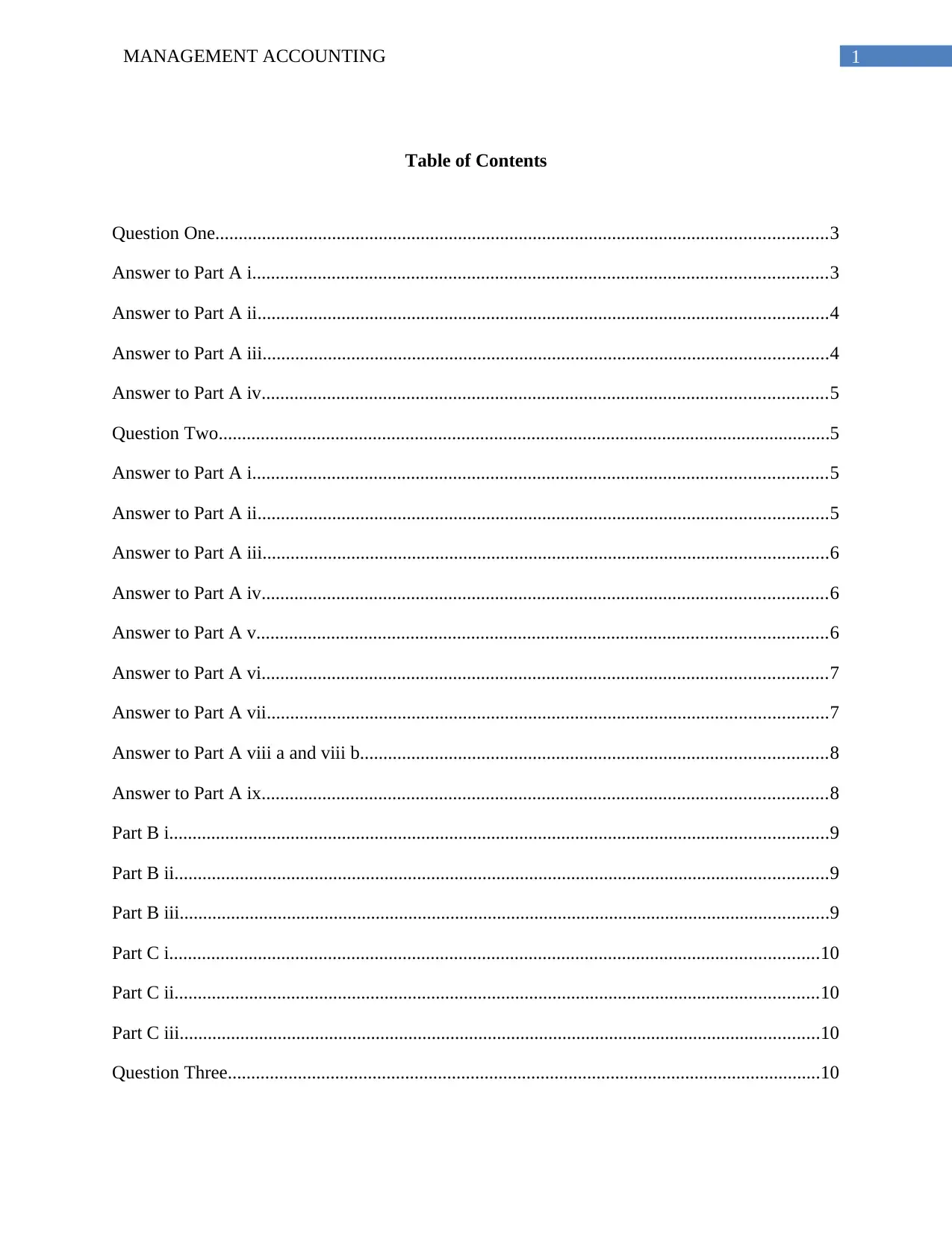
1MANAGEMENT ACCOUNTING
Table of Contents
Question One...................................................................................................................................3
Answer to Part A i...........................................................................................................................3
Answer to Part A ii..........................................................................................................................4
Answer to Part A iii.........................................................................................................................4
Answer to Part A iv.........................................................................................................................5
Question Two...................................................................................................................................5
Answer to Part A i...........................................................................................................................5
Answer to Part A ii..........................................................................................................................5
Answer to Part A iii.........................................................................................................................6
Answer to Part A iv.........................................................................................................................6
Answer to Part A v..........................................................................................................................6
Answer to Part A vi.........................................................................................................................7
Answer to Part A vii........................................................................................................................7
Answer to Part A viii a and viii b....................................................................................................8
Answer to Part A ix.........................................................................................................................8
Part B i.............................................................................................................................................9
Part B ii............................................................................................................................................9
Part B iii...........................................................................................................................................9
Part C i...........................................................................................................................................10
Part C ii..........................................................................................................................................10
Part C iii.........................................................................................................................................10
Question Three...............................................................................................................................10
Table of Contents
Question One...................................................................................................................................3
Answer to Part A i...........................................................................................................................3
Answer to Part A ii..........................................................................................................................4
Answer to Part A iii.........................................................................................................................4
Answer to Part A iv.........................................................................................................................5
Question Two...................................................................................................................................5
Answer to Part A i...........................................................................................................................5
Answer to Part A ii..........................................................................................................................5
Answer to Part A iii.........................................................................................................................6
Answer to Part A iv.........................................................................................................................6
Answer to Part A v..........................................................................................................................6
Answer to Part A vi.........................................................................................................................7
Answer to Part A vii........................................................................................................................7
Answer to Part A viii a and viii b....................................................................................................8
Answer to Part A ix.........................................................................................................................8
Part B i.............................................................................................................................................9
Part B ii............................................................................................................................................9
Part B iii...........................................................................................................................................9
Part C i...........................................................................................................................................10
Part C ii..........................................................................................................................................10
Part C iii.........................................................................................................................................10
Question Three...............................................................................................................................10
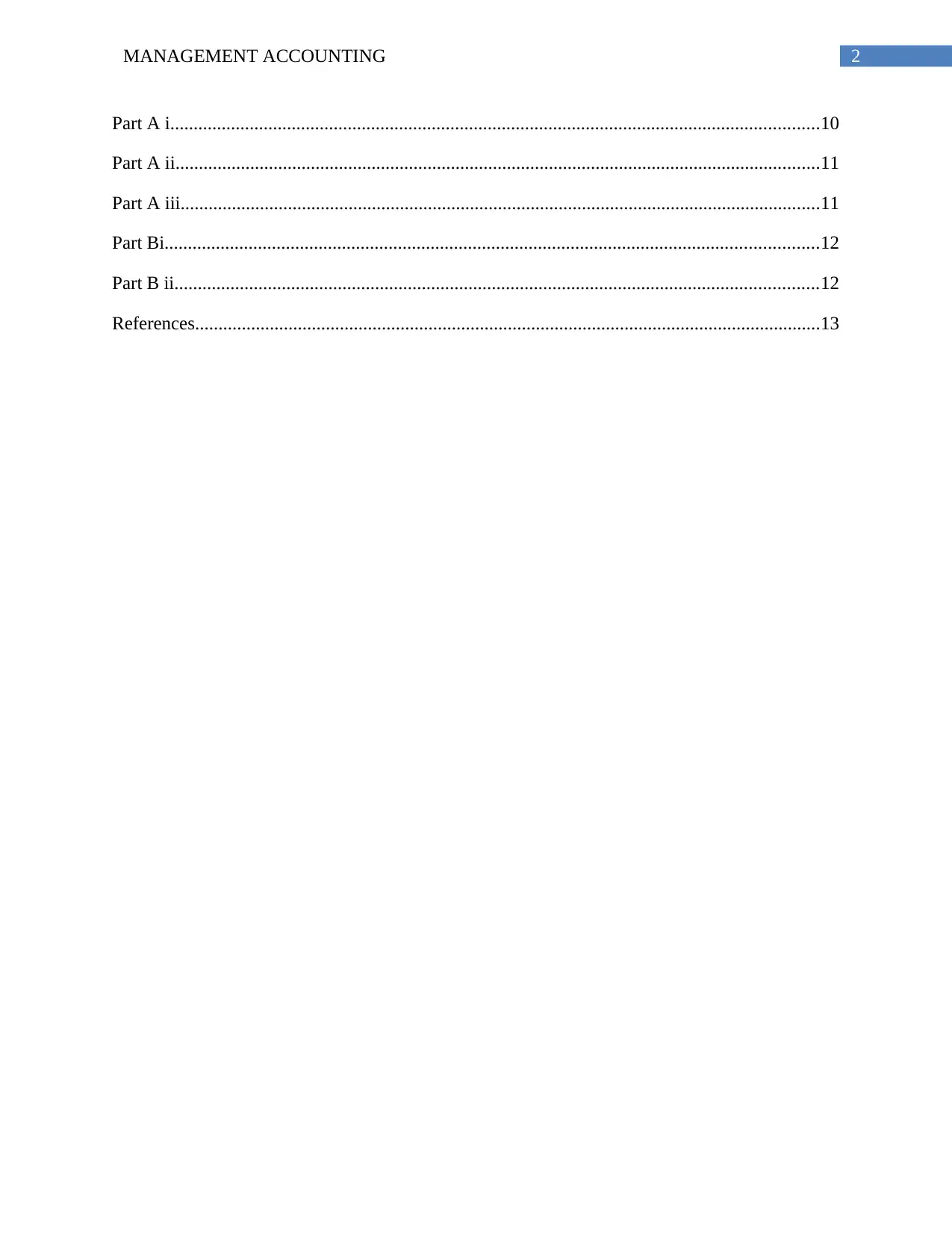
2MANAGEMENT ACCOUNTING
Part A i...........................................................................................................................................10
Part A ii..........................................................................................................................................11
Part A iii.........................................................................................................................................11
Part Bi............................................................................................................................................12
Part B ii..........................................................................................................................................12
References......................................................................................................................................13
Part A i...........................................................................................................................................10
Part A ii..........................................................................................................................................11
Part A iii.........................................................................................................................................11
Part Bi............................................................................................................................................12
Part B ii..........................................................................................................................................12
References......................................................................................................................................13
⊘ This is a preview!⊘
Do you want full access?
Subscribe today to unlock all pages.

Trusted by 1+ million students worldwide
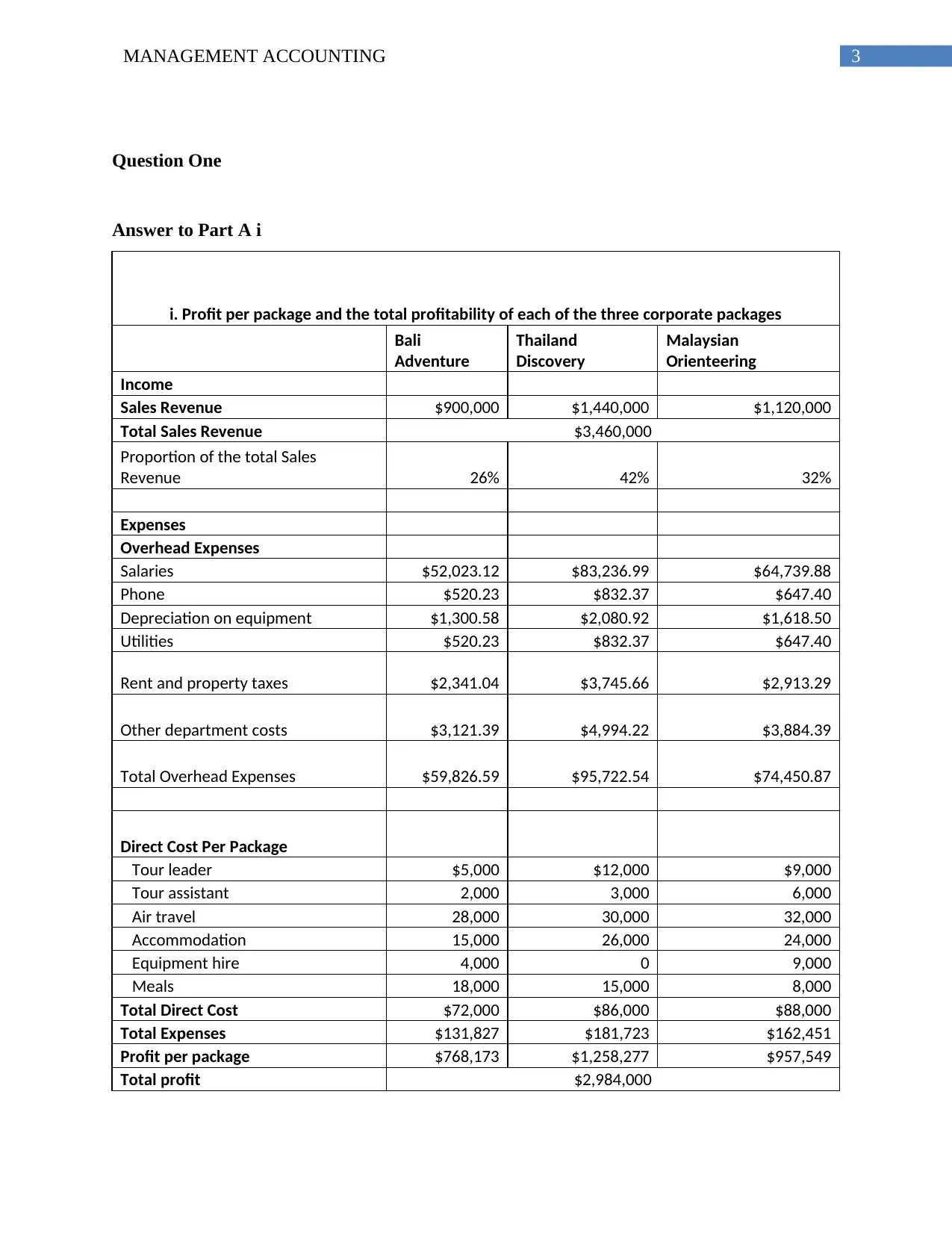
3MANAGEMENT ACCOUNTING
Question One
Answer to Part A i
i. Profit per package and the total profitability of each of the three corporate packages
Bali
Adventure
Thailand
Discovery
Malaysian
Orienteering
Income
Sales Revenue $900,000 $1,440,000 $1,120,000
Total Sales Revenue $3,460,000
Proportion of the total Sales
Revenue 26% 42% 32%
Expenses
Overhead Expenses
Salaries $52,023.12 $83,236.99 $64,739.88
Phone $520.23 $832.37 $647.40
Depreciation on equipment $1,300.58 $2,080.92 $1,618.50
Utilities $520.23 $832.37 $647.40
Rent and property taxes $2,341.04 $3,745.66 $2,913.29
Other department costs $3,121.39 $4,994.22 $3,884.39
Total Overhead Expenses $59,826.59 $95,722.54 $74,450.87
Direct Cost Per Package
Tour leader $5,000 $12,000 $9,000
Tour assistant 2,000 3,000 6,000
Air travel 28,000 30,000 32,000
Accommodation 15,000 26,000 24,000
Equipment hire 4,000 0 9,000
Meals 18,000 15,000 8,000
Total Direct Cost $72,000 $86,000 $88,000
Total Expenses $131,827 $181,723 $162,451
Profit per package $768,173 $1,258,277 $957,549
Total profit $2,984,000
Question One
Answer to Part A i
i. Profit per package and the total profitability of each of the three corporate packages
Bali
Adventure
Thailand
Discovery
Malaysian
Orienteering
Income
Sales Revenue $900,000 $1,440,000 $1,120,000
Total Sales Revenue $3,460,000
Proportion of the total Sales
Revenue 26% 42% 32%
Expenses
Overhead Expenses
Salaries $52,023.12 $83,236.99 $64,739.88
Phone $520.23 $832.37 $647.40
Depreciation on equipment $1,300.58 $2,080.92 $1,618.50
Utilities $520.23 $832.37 $647.40
Rent and property taxes $2,341.04 $3,745.66 $2,913.29
Other department costs $3,121.39 $4,994.22 $3,884.39
Total Overhead Expenses $59,826.59 $95,722.54 $74,450.87
Direct Cost Per Package
Tour leader $5,000 $12,000 $9,000
Tour assistant 2,000 3,000 6,000
Air travel 28,000 30,000 32,000
Accommodation 15,000 26,000 24,000
Equipment hire 4,000 0 9,000
Meals 18,000 15,000 8,000
Total Direct Cost $72,000 $86,000 $88,000
Total Expenses $131,827 $181,723 $162,451
Profit per package $768,173 $1,258,277 $957,549
Total profit $2,984,000
Paraphrase This Document
Need a fresh take? Get an instant paraphrase of this document with our AI Paraphraser

4MANAGEMENT ACCOUNTING
Answer to Part A ii
ii. Comparison of profitability of the three corporate packages
Bali
Adventure
Thailand
Discovery
Malaysian
Orienteering
Sales Revenue $900,000
$1,440,00
0 $1,120,000
Profit per package $768,173
$1,258,27
7 $957,549
Bali Adventure Thailand Discovery Malaysian Orienteering
$0
$200,000
$400,000
$600,000
$800,000
$1,000,000
$1,200,000
$1,400,000
$1,600,000
$900,000
$1,440,000
$1,120,000
$768,173
$1,258,277
$957,549
Comparison of profitability of the three corporate
packages
Sales Revenue Profit per package
Figure: Comparison of profitability of the three corporate packages
(Source: As per the Author)
Answer to Part A iii
In my opinion the method of Proportion of the total Sales Revenue does not consider the
individual percentage of the subcategories such as Revenue per person and number of people per
package. The system has significant scope of improvement by including the subcategories of the
various parameters.
Answer to Part A ii
ii. Comparison of profitability of the three corporate packages
Bali
Adventure
Thailand
Discovery
Malaysian
Orienteering
Sales Revenue $900,000
$1,440,00
0 $1,120,000
Profit per package $768,173
$1,258,27
7 $957,549
Bali Adventure Thailand Discovery Malaysian Orienteering
$0
$200,000
$400,000
$600,000
$800,000
$1,000,000
$1,200,000
$1,400,000
$1,600,000
$900,000
$1,440,000
$1,120,000
$768,173
$1,258,277
$957,549
Comparison of profitability of the three corporate
packages
Sales Revenue Profit per package
Figure: Comparison of profitability of the three corporate packages
(Source: As per the Author)
Answer to Part A iii
In my opinion the method of Proportion of the total Sales Revenue does not consider the
individual percentage of the subcategories such as Revenue per person and number of people per
package. The system has significant scope of improvement by including the subcategories of the
various parameters.
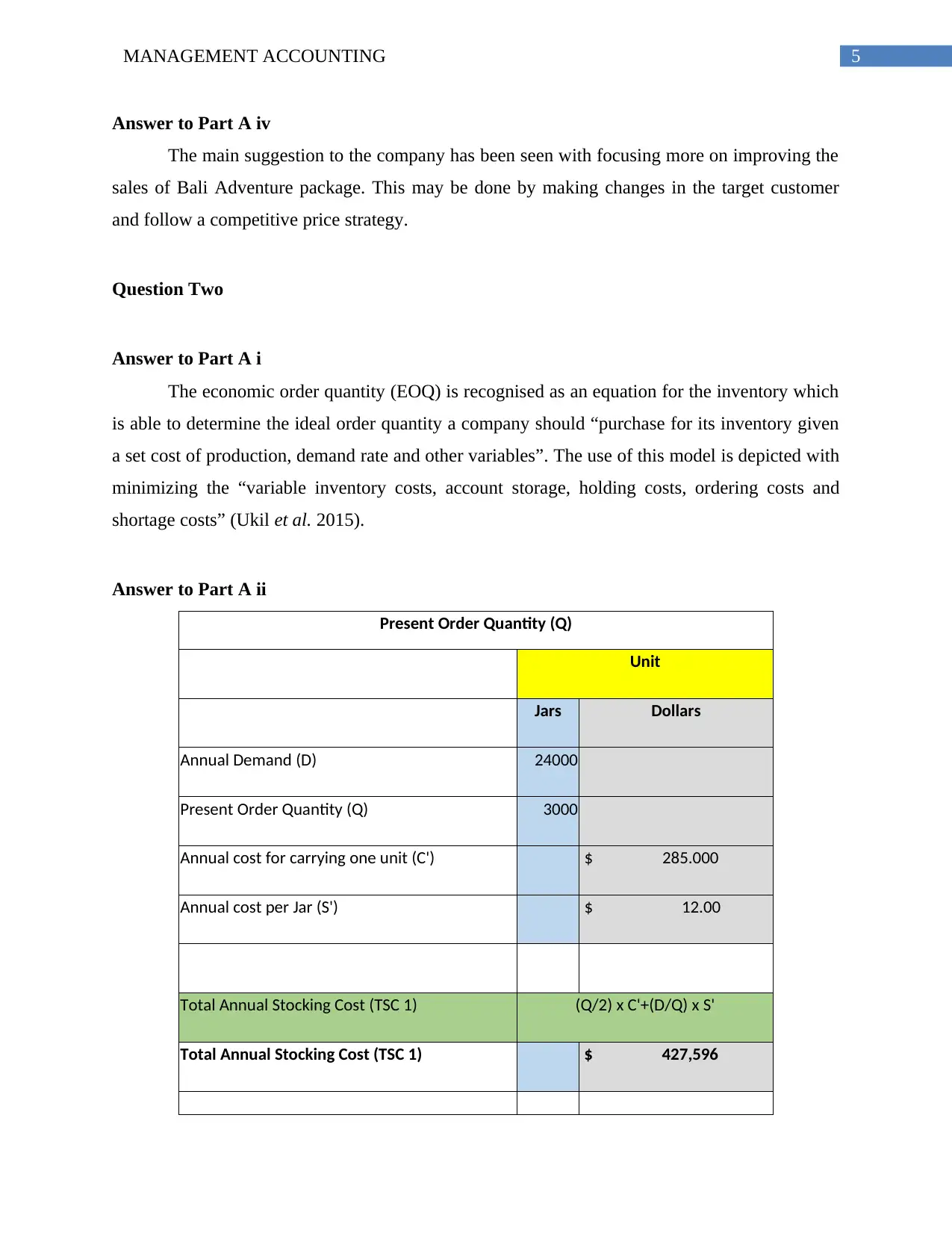
5MANAGEMENT ACCOUNTING
Answer to Part A iv
The main suggestion to the company has been seen with focusing more on improving the
sales of Bali Adventure package. This may be done by making changes in the target customer
and follow a competitive price strategy.
Question Two
Answer to Part A i
The economic order quantity (EOQ) is recognised as an equation for the inventory which
is able to determine the ideal order quantity a company should “purchase for its inventory given
a set cost of production, demand rate and other variables”. The use of this model is depicted with
minimizing the “variable inventory costs, account storage, holding costs, ordering costs and
shortage costs” (Ukil et al. 2015).
Answer to Part A ii
Present Order Quantity (Q)
Unit
Jars Dollars
Annual Demand (D) 24000
Present Order Quantity (Q) 3000
Annual cost for carrying one unit (C') $ 285.000
Annual cost per Jar (S') $ 12.00
Total Annual Stocking Cost (TSC 1) (Q/2) x C'+(D/Q) x S'
Total Annual Stocking Cost (TSC 1) $ 427,596
Answer to Part A iv
The main suggestion to the company has been seen with focusing more on improving the
sales of Bali Adventure package. This may be done by making changes in the target customer
and follow a competitive price strategy.
Question Two
Answer to Part A i
The economic order quantity (EOQ) is recognised as an equation for the inventory which
is able to determine the ideal order quantity a company should “purchase for its inventory given
a set cost of production, demand rate and other variables”. The use of this model is depicted with
minimizing the “variable inventory costs, account storage, holding costs, ordering costs and
shortage costs” (Ukil et al. 2015).
Answer to Part A ii
Present Order Quantity (Q)
Unit
Jars Dollars
Annual Demand (D) 24000
Present Order Quantity (Q) 3000
Annual cost for carrying one unit (C') $ 285.000
Annual cost per Jar (S') $ 12.00
Total Annual Stocking Cost (TSC 1) (Q/2) x C'+(D/Q) x S'
Total Annual Stocking Cost (TSC 1) $ 427,596
⊘ This is a preview!⊘
Do you want full access?
Subscribe today to unlock all pages.

Trusted by 1+ million students worldwide
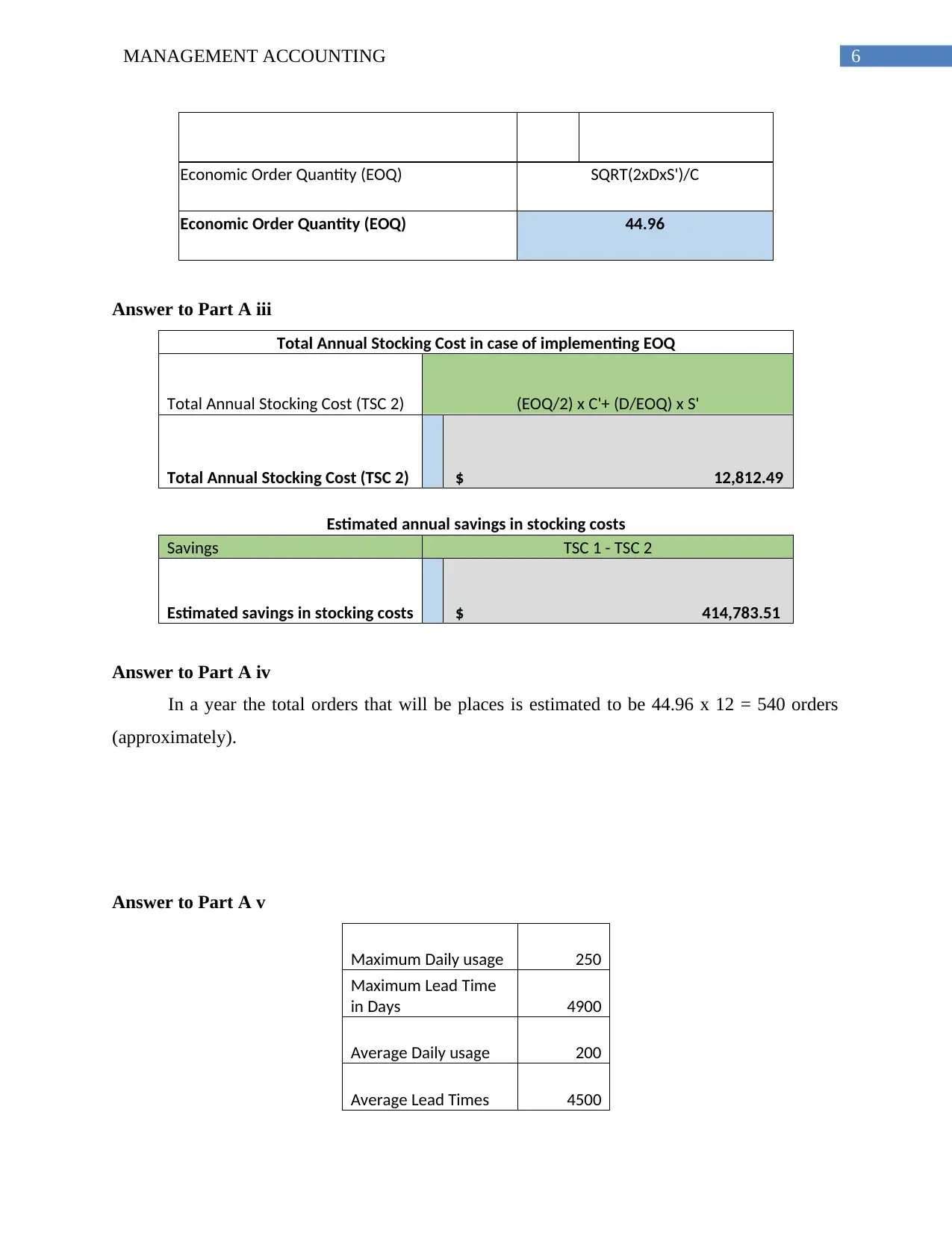
6MANAGEMENT ACCOUNTING
Economic Order Quantity (EOQ) SQRT(2xDxS')/C
Economic Order Quantity (EOQ) 44.96
Answer to Part A iii
Total Annual Stocking Cost in case of implementing EOQ
Total Annual Stocking Cost (TSC 2) (EOQ/2) x C'+ (D/EOQ) x S'
Total Annual Stocking Cost (TSC 2) $ 12,812.49
Estimated annual savings in stocking costs
Savings TSC 1 - TSC 2
Estimated savings in stocking costs $ 414,783.51
Answer to Part A iv
In a year the total orders that will be places is estimated to be 44.96 x 12 = 540 orders
(approximately).
Answer to Part A v
Maximum Daily usage 250
Maximum Lead Time
in Days 4900
Average Daily usage 200
Average Lead Times 4500
Economic Order Quantity (EOQ) SQRT(2xDxS')/C
Economic Order Quantity (EOQ) 44.96
Answer to Part A iii
Total Annual Stocking Cost in case of implementing EOQ
Total Annual Stocking Cost (TSC 2) (EOQ/2) x C'+ (D/EOQ) x S'
Total Annual Stocking Cost (TSC 2) $ 12,812.49
Estimated annual savings in stocking costs
Savings TSC 1 - TSC 2
Estimated savings in stocking costs $ 414,783.51
Answer to Part A iv
In a year the total orders that will be places is estimated to be 44.96 x 12 = 540 orders
(approximately).
Answer to Part A v
Maximum Daily usage 250
Maximum Lead Time
in Days 4900
Average Daily usage 200
Average Lead Times 4500
Paraphrase This Document
Need a fresh take? Get an instant paraphrase of this document with our AI Paraphraser
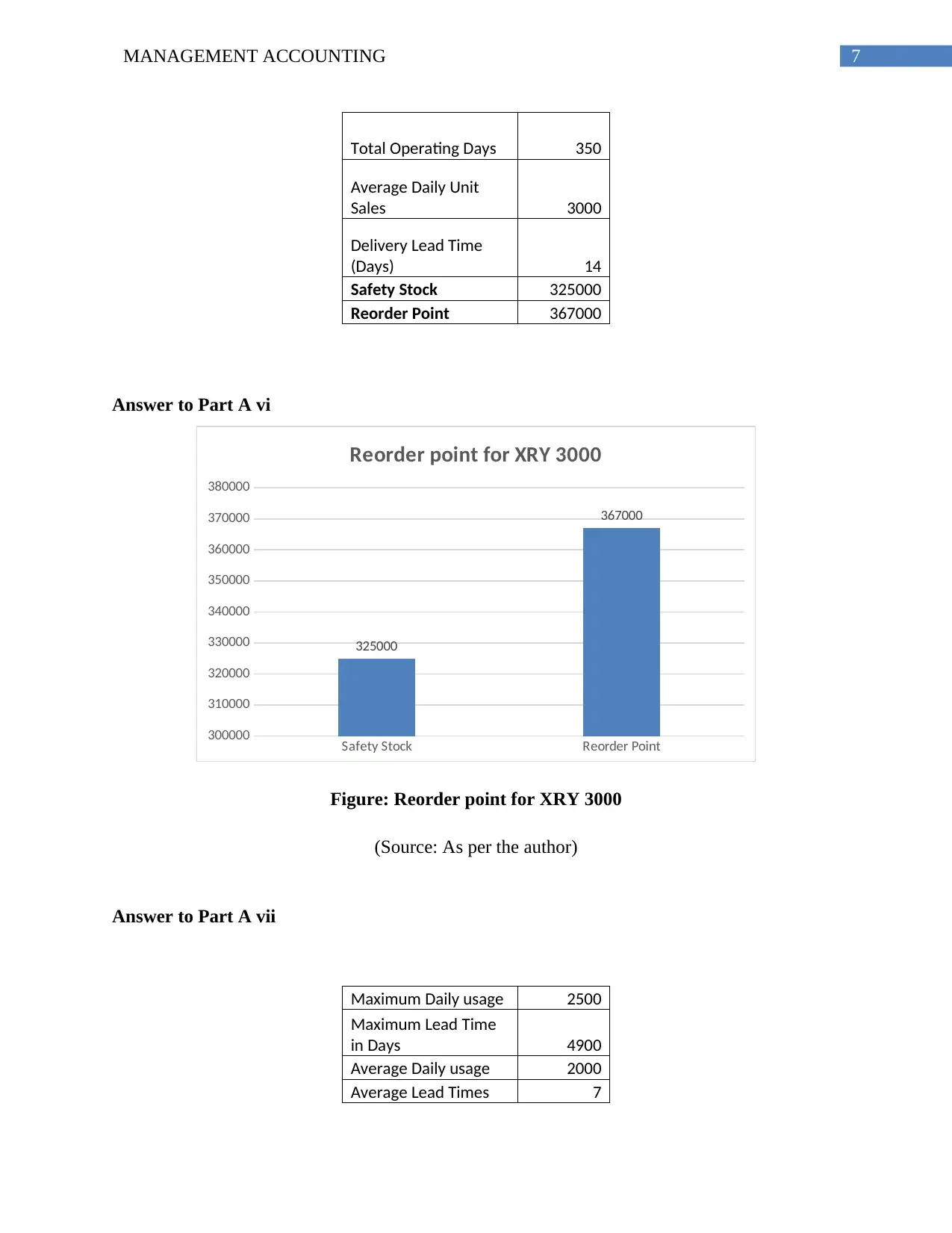
7MANAGEMENT ACCOUNTING
Total Operating Days 350
Average Daily Unit
Sales 3000
Delivery Lead Time
(Days) 14
Safety Stock 325000
Reorder Point 367000
Answer to Part A vi
Safety Stock Reorder Point
300000
310000
320000
330000
340000
350000
360000
370000
380000
325000
367000
Reorder point for XRY 3000
Figure: Reorder point for XRY 3000
(Source: As per the author)
Answer to Part A vii
Maximum Daily usage 2500
Maximum Lead Time
in Days 4900
Average Daily usage 2000
Average Lead Times 7
Total Operating Days 350
Average Daily Unit
Sales 3000
Delivery Lead Time
(Days) 14
Safety Stock 325000
Reorder Point 367000
Answer to Part A vi
Safety Stock Reorder Point
300000
310000
320000
330000
340000
350000
360000
370000
380000
325000
367000
Reorder point for XRY 3000
Figure: Reorder point for XRY 3000
(Source: As per the author)
Answer to Part A vii
Maximum Daily usage 2500
Maximum Lead Time
in Days 4900
Average Daily usage 2000
Average Lead Times 7
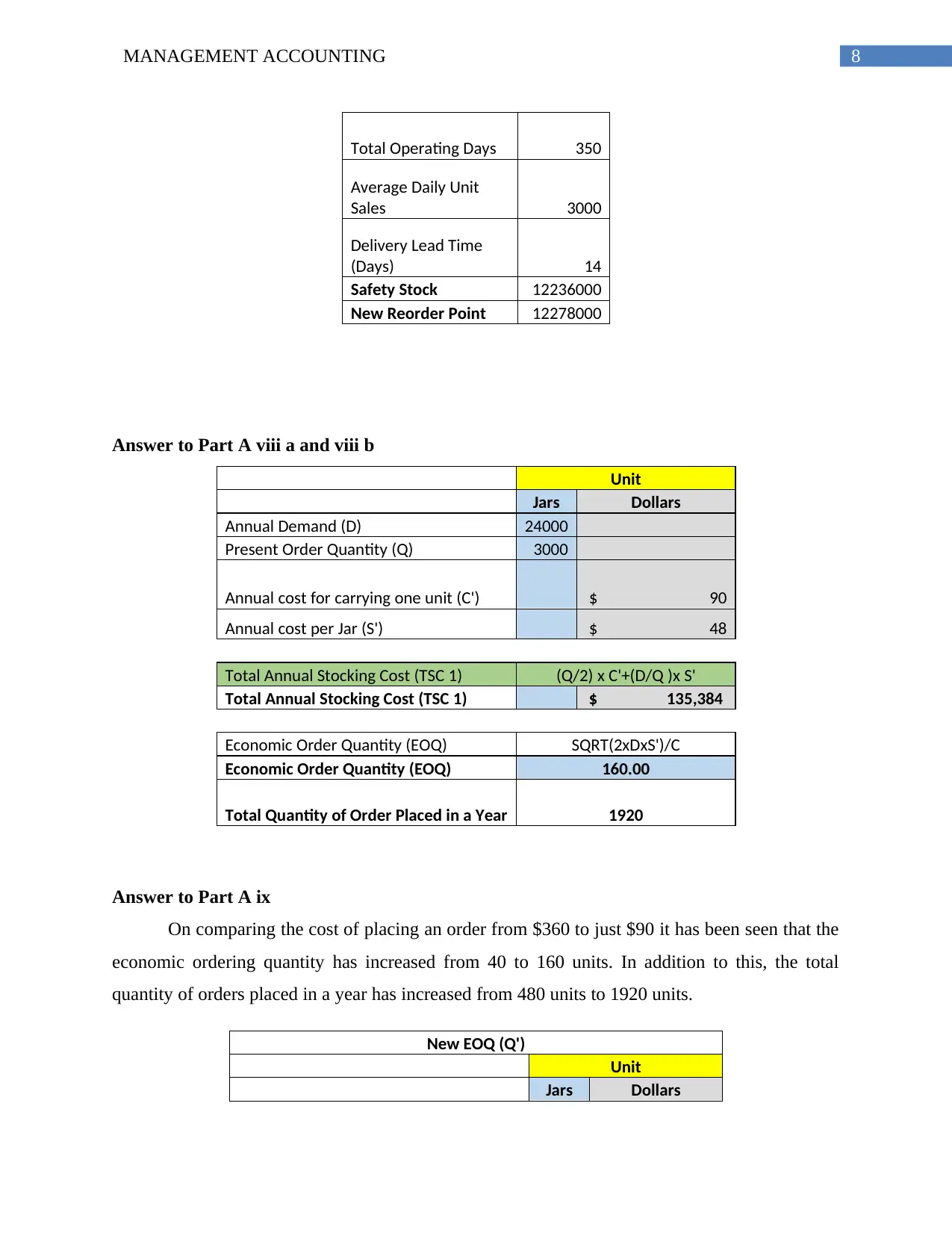
8MANAGEMENT ACCOUNTING
Total Operating Days 350
Average Daily Unit
Sales 3000
Delivery Lead Time
(Days) 14
Safety Stock 12236000
New Reorder Point 12278000
Answer to Part A viii a and viii b
Unit
Jars Dollars
Annual Demand (D) 24000
Present Order Quantity (Q) 3000
Annual cost for carrying one unit (C') $ 90
Annual cost per Jar (S') $ 48
Total Annual Stocking Cost (TSC 1) (Q/2) x C'+(D/Q )x S'
Total Annual Stocking Cost (TSC 1) $ 135,384
Economic Order Quantity (EOQ) SQRT(2xDxS')/C
Economic Order Quantity (EOQ) 160.00
Total Quantity of Order Placed in a Year 1920
Answer to Part A ix
On comparing the cost of placing an order from $360 to just $90 it has been seen that the
economic ordering quantity has increased from 40 to 160 units. In addition to this, the total
quantity of orders placed in a year has increased from 480 units to 1920 units.
New EOQ (Q')
Unit
Jars Dollars
Total Operating Days 350
Average Daily Unit
Sales 3000
Delivery Lead Time
(Days) 14
Safety Stock 12236000
New Reorder Point 12278000
Answer to Part A viii a and viii b
Unit
Jars Dollars
Annual Demand (D) 24000
Present Order Quantity (Q) 3000
Annual cost for carrying one unit (C') $ 90
Annual cost per Jar (S') $ 48
Total Annual Stocking Cost (TSC 1) (Q/2) x C'+(D/Q )x S'
Total Annual Stocking Cost (TSC 1) $ 135,384
Economic Order Quantity (EOQ) SQRT(2xDxS')/C
Economic Order Quantity (EOQ) 160.00
Total Quantity of Order Placed in a Year 1920
Answer to Part A ix
On comparing the cost of placing an order from $360 to just $90 it has been seen that the
economic ordering quantity has increased from 40 to 160 units. In addition to this, the total
quantity of orders placed in a year has increased from 480 units to 1920 units.
New EOQ (Q')
Unit
Jars Dollars
⊘ This is a preview!⊘
Do you want full access?
Subscribe today to unlock all pages.

Trusted by 1+ million students worldwide
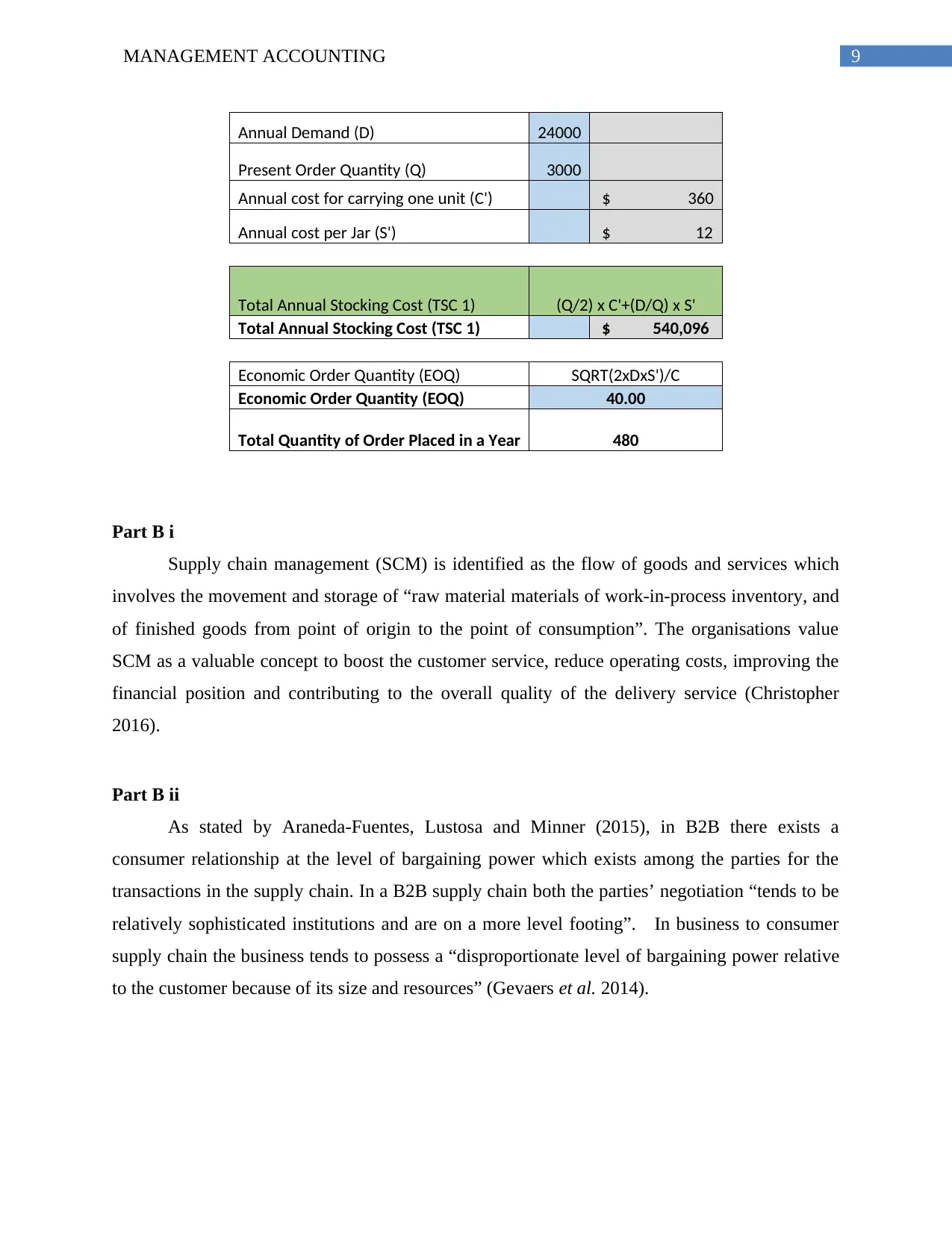
9MANAGEMENT ACCOUNTING
Annual Demand (D) 24000
Present Order Quantity (Q) 3000
Annual cost for carrying one unit (C') $ 360
Annual cost per Jar (S') $ 12
Total Annual Stocking Cost (TSC 1) (Q/2) x C'+(D/Q) x S'
Total Annual Stocking Cost (TSC 1) $ 540,096
Economic Order Quantity (EOQ) SQRT(2xDxS')/C
Economic Order Quantity (EOQ) 40.00
Total Quantity of Order Placed in a Year 480
Part B i
Supply chain management (SCM) is identified as the flow of goods and services which
involves the movement and storage of “raw material materials of work-in-process inventory, and
of finished goods from point of origin to the point of consumption”. The organisations value
SCM as a valuable concept to boost the customer service, reduce operating costs, improving the
financial position and contributing to the overall quality of the delivery service (Christopher
2016).
Part B ii
As stated by Araneda-Fuentes, Lustosa and Minner (2015), in B2B there exists a
consumer relationship at the level of bargaining power which exists among the parties for the
transactions in the supply chain. In a B2B supply chain both the parties’ negotiation “tends to be
relatively sophisticated institutions and are on a more level footing”. In business to consumer
supply chain the business tends to possess a “disproportionate level of bargaining power relative
to the customer because of its size and resources” (Gevaers et al. 2014).
Annual Demand (D) 24000
Present Order Quantity (Q) 3000
Annual cost for carrying one unit (C') $ 360
Annual cost per Jar (S') $ 12
Total Annual Stocking Cost (TSC 1) (Q/2) x C'+(D/Q) x S'
Total Annual Stocking Cost (TSC 1) $ 540,096
Economic Order Quantity (EOQ) SQRT(2xDxS')/C
Economic Order Quantity (EOQ) 40.00
Total Quantity of Order Placed in a Year 480
Part B i
Supply chain management (SCM) is identified as the flow of goods and services which
involves the movement and storage of “raw material materials of work-in-process inventory, and
of finished goods from point of origin to the point of consumption”. The organisations value
SCM as a valuable concept to boost the customer service, reduce operating costs, improving the
financial position and contributing to the overall quality of the delivery service (Christopher
2016).
Part B ii
As stated by Araneda-Fuentes, Lustosa and Minner (2015), in B2B there exists a
consumer relationship at the level of bargaining power which exists among the parties for the
transactions in the supply chain. In a B2B supply chain both the parties’ negotiation “tends to be
relatively sophisticated institutions and are on a more level footing”. In business to consumer
supply chain the business tends to possess a “disproportionate level of bargaining power relative
to the customer because of its size and resources” (Gevaers et al. 2014).
Paraphrase This Document
Need a fresh take? Get an instant paraphrase of this document with our AI Paraphraser

10MANAGEMENT ACCOUNTING
Part B iii
It is important for organisations to create collaborative relationships with suppliers to link
the network in the right way. The “placing relationships at the centre of supply chain
management allows for a more collaborative and effective dynamic performance for the
companies”. The best supply chains relationships are based on value and consistent adherence to
the same. These values are based on factors such as “services, quality, on-time deliveries, returns
management, or some combination of these”. Moreover, “long-term supply chain collaboration”
are the cost savings that result from routinized procedures and reduction in the indirect costs
(Fawcett et al. 2015).
Part C i
Customer Relationship Management is identified as a practice to analyse and manage
customer interactions and data in the entire customer lifecycle, with the aim of improving
customer service relationship, retaining the customers and achieve sales growth (Khodakarami
and Chan 2014).
Part C ii
The application of the CRM will be conducive in understanding the technical drawbacks
in the system and will provide Mitty Pty Ltd to take a step forward in increasing the sales
growth.
Part C iii
The use of e-commerce will be conducive in sourcing the products at a much cheaper
price in compared to the conventional methods. This will also allow the company to source the
vendors of the raw materials who will provide the best value (Qureshi et al. 2016.)
Part B iii
It is important for organisations to create collaborative relationships with suppliers to link
the network in the right way. The “placing relationships at the centre of supply chain
management allows for a more collaborative and effective dynamic performance for the
companies”. The best supply chains relationships are based on value and consistent adherence to
the same. These values are based on factors such as “services, quality, on-time deliveries, returns
management, or some combination of these”. Moreover, “long-term supply chain collaboration”
are the cost savings that result from routinized procedures and reduction in the indirect costs
(Fawcett et al. 2015).
Part C i
Customer Relationship Management is identified as a practice to analyse and manage
customer interactions and data in the entire customer lifecycle, with the aim of improving
customer service relationship, retaining the customers and achieve sales growth (Khodakarami
and Chan 2014).
Part C ii
The application of the CRM will be conducive in understanding the technical drawbacks
in the system and will provide Mitty Pty Ltd to take a step forward in increasing the sales
growth.
Part C iii
The use of e-commerce will be conducive in sourcing the products at a much cheaper
price in compared to the conventional methods. This will also allow the company to source the
vendors of the raw materials who will provide the best value (Qureshi et al. 2016.)

11MANAGEMENT ACCOUNTING
Question Three
Part A i
Quality Report
Type of Cost Amount
Percentage of
Total Quality Cost
Production Cost
Training of quality control personnel 54,000
18%
Inspection of circuit boards purchased from outside suppliers 129,600
Total Production Cost 183,600
Appraisal Cost
Tests of A.I. before sales 108,000 11%
Total Appraisal Cost 108,000
Internal Failure Cost
Cost of rework on faulty artificial intelligence (A.I.) 205,200
27%
Cost of defective parts that had to be scrapped 65,880
Total Internal Failure Cost 271,080
External Failure Cost
Replacement of faulty A.I. under warranty 459,000 45%
Total External Failure Cost 459,000
Total Quality Cost 1,021,680
Part A ii
The management needs to take immediate measures to increase the production quality to
bring down the percentage cost of external failure cost caused due to replacement of faulty A.I.
under warranty. The poor quality is also evident with only 18% cost allocation in the training of
quality control personnel. More investment needs to be made by the management in this area.
Question Three
Part A i
Quality Report
Type of Cost Amount
Percentage of
Total Quality Cost
Production Cost
Training of quality control personnel 54,000
18%
Inspection of circuit boards purchased from outside suppliers 129,600
Total Production Cost 183,600
Appraisal Cost
Tests of A.I. before sales 108,000 11%
Total Appraisal Cost 108,000
Internal Failure Cost
Cost of rework on faulty artificial intelligence (A.I.) 205,200
27%
Cost of defective parts that had to be scrapped 65,880
Total Internal Failure Cost 271,080
External Failure Cost
Replacement of faulty A.I. under warranty 459,000 45%
Total External Failure Cost 459,000
Total Quality Cost 1,021,680
Part A ii
The management needs to take immediate measures to increase the production quality to
bring down the percentage cost of external failure cost caused due to replacement of faulty A.I.
under warranty. The poor quality is also evident with only 18% cost allocation in the training of
quality control personnel. More investment needs to be made by the management in this area.
⊘ This is a preview!⊘
Do you want full access?
Subscribe today to unlock all pages.

Trusted by 1+ million students worldwide
1 out of 15
Related Documents
Your All-in-One AI-Powered Toolkit for Academic Success.
+13062052269
info@desklib.com
Available 24*7 on WhatsApp / Email
![[object Object]](/_next/static/media/star-bottom.7253800d.svg)
Unlock your academic potential
Copyright © 2020–2025 A2Z Services. All Rights Reserved. Developed and managed by ZUCOL.





